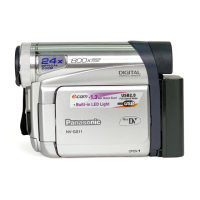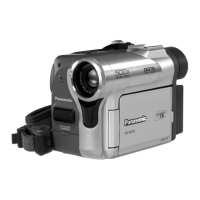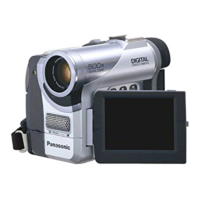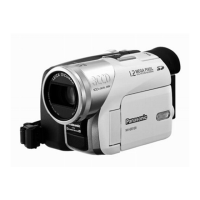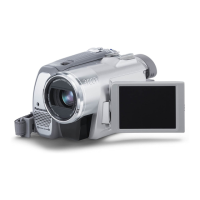Do you have a question about the Panasonic NV-GS15EB and is the answer not in the manual?
Safety instructions for the mains lead, including fuse replacement steps.
Notes on card compatibility, safe storage, and copyright adherence.
Information on customer care, technical support, and sales channels.
Lists and descriptions of standard and optional accessories.
Identifies and describes controls specific to the NV-GS15 model.
Identifies and describes controls specific to the NV-GS8/NV-GS11 models.
Details on the LCD monitor, card slot, and external buttons.
Description of DV, A/V OUT, Headphone, and MIC sockets.
Details on the remote control sensor and dedicated socket.
Usage instructions for the free style remote controller.
Instructions for using the standard remote controller and installing its battery.
How to set up remote control modes on the camera and controller.
Instructions for powering the camera using the AC adaptor.
Steps for charging the camera battery using the AC adaptor.
Instructions for removing the battery and using an optional car charger.
Guides for attaching and using the grip belt, lens cap, and shoulder strap.
Procedures for loading cassettes and preventing accidental recording.
Instructions for inserting and removing SD/MultiMedia cards.
Steps to turn the camera on/off and switch modes.
Instructions for using the display screens.
Adjusting LCD position, brightness, and color.
Guide to accessing and using camera menus.
How to select files for playback operations.
Lists the main menu categories and their functions.
How to use demo mode and options within tape playback menus.
Details on options within the card recording menu.
Card formatting and digital effect menu details.
Procedure to set the internal clock of the camera.
Charging the internal battery and LP recording mode features.
Options for audio recording quality.
Basic guidelines for recording on tape, including steps.
How to record still pictures to a card while recording video to tape.
How to check recordings, find tape ends, and capture stills.
Advanced still picture capture modes.
Capturing still images on SD/MultiMedia cards.
How to use the camera's LED light for illumination.
Features for rapid recording, self-timer, and zoom control.
Enhancing close-up focus, audio, zoom, and correcting camera shake.
Applying gradual transitions to video.
Adjusting for backlighting and low-light conditions.
Applying stylistic effects to recordings.
Using automatic exposure modes for specific scenes.
Detailed descriptions of various scene modes.
How to manually set white balance for natural colors.
Controlling exposure time for fast-moving subjects.
Adjusting aperture and focus manually.
Using various creative filters and effects.
Capturing multiple small images.
Layering images and creating transition effects.
How to play back recorded video and control audio level.
Navigating through recordings quickly and finding specific scenes.
Controlling playback speed, direction, and viewing still frames.
Using index signals to find specific scenes.
Enlarging playback images and applying digital effects.
Accessing and playing files stored on memory cards.
Viewing still pictures as a slideshow and adding custom titles.
Overlaying titles and configuring print order data.
Locking files, removing files, and preparing memory cards.
How to view recordings on a television screen.
Copying images and adding narration/music to recordings.
Copying images from memory card to tape.
Various dubbing methods and digital transfers.
Transferring photos and using camera with PC software.
Understanding how files are organized on memory cards accessed via PC.
Explains the meaning of various icons and indicators.
Alphabetical reference to camera features and their pages.
Adjusting display modes and resetting camera settings.
Interpreting system alerts and error indicators.
Tips for power, cassette management, and audio alerts.
Verifying recordings, card notes, and rapid camera readiness.
Using self-timer, zoom, and LED light.
Enhancing audio, zoom, image quality, and special lighting effects.
Using scene modes and automatic exposure.
Fine-tuning exposure settings manually.
Applying creative effects and managing playback.
Listening via headphones, selecting audio, and finding scenes.
Managing and viewing content on memory cards.
Print settings, file locking, TV output, and editing operations.
Important warnings and post-use procedures.
Avoiding interference and improper use.
Handling the adaptor and condensation.
Dealing with moisture, fogged lenses, and video head maintenance.
General upkeep, battery best practices, and disposal.
Maintaining battery contacts, storage, and card handling.
Guidelines for using and storing these display and lens components.
Diagnosing and resolving power, battery, and recording failures.
Troubleshooting focus, editing, and display issues.
Resolving issues with tape indicators, playback, cards, and remote control.
Troubleshooting PC connections and other playback problems.
Resetting the camera, understanding focus, and technical terms.
Technical explanations of core concepts.
Controlling tape position for editing and dubbing.
Detailed technical data for the camera.
Technical details for the power adapter.



